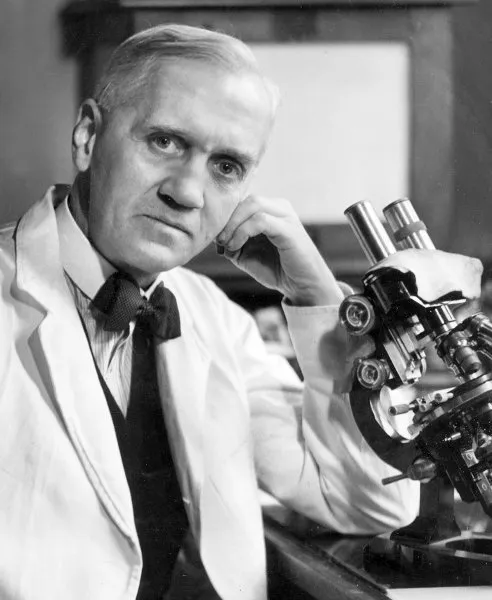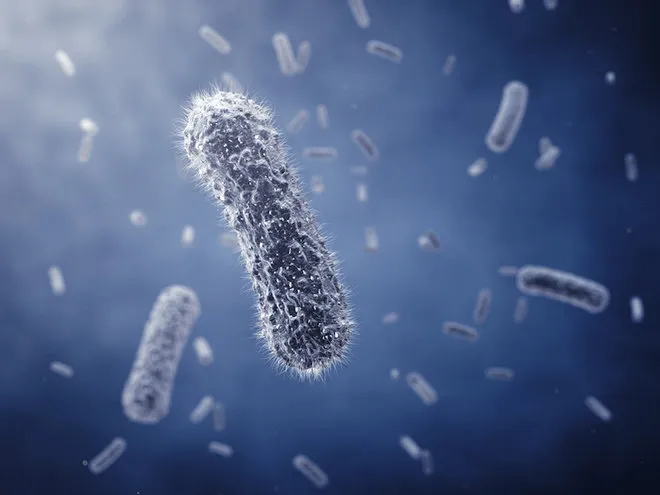Alexandar Fleming
Sir Alexander Fleming (6 August 1881 – 11 March 1955) was a Scottish physician, microbiologist, and pharmacologist. His best-known discoveries are the enzyme lysozyme in 1923 and the world's first antibiotic substance benzylpenicillin (Penicillin G) from the mould Penicillium notatum in 1928, for which he shared the Nobel Prize in Physiology or Medicine in 1945 with Howard Florey and Ernst Boris Chain. He wrote many articles on bacteriology, immunology, and chemotherapy.

The ability of penicillin to cure bacterial infections has saved millions and millions of lives, and many still call it a "miracle". Bacterial infections have been far more deadly than today, and by far more people were "infected" by it. You may not know, but the fact is that most of the soldiers who died during the Second World War were not directly killed by bullets or explosives, but were dying of bacterial infections in the wounds caused by weapons. Yet , story of penicillin and antibiotics that has been successfully used begins with coincidence.
As a twenty-year-old, Fleming enrolls in a medical school and then participates in the First World War, working in hospitals on the western front in France. Exposed to the infections of dying soldiers, he began to study the bacteria that were the cause of many diseases. Up to its discovery, Fleming "addmitet" he discovered it accidentaly, but as it is mentioned in the title: Chance Favors The Prepared Mind
How It Happened, and How does Penicilin kill Bacteria.
When I woke up just after dawn on September 28, 1928, I certainly didn't plan to revolutionise all medicine by discovering the world's first antibiotic, or bacteria killer. But I suppose that was exactly what I did.
On 3 September 1928, Fleming returned to his laboratory having spent August on holiday with his family. Before leaving, he had stacked all his cultures of staphylococci on a bench in a corner of his laboratory. On returning, Fleming noticed that one culture was contaminated with a fungus, and that the colonies of staphylococci immediately surrounding the fungus had been destroyed, whereas other staphylococci colonies farther away were normal.

Briefly, penicillins bind to a group of bacterial proteins characteristic of their affinity to penicillin, which is also referred to as penicillin-binding proteins (PVPs). Penicillin-binding proteins are located on the outer side of the plasma membrane of bacteria and perform different enzymatic roles, most commonly acting as transpeptidases, carboxypeptidases or endopeptidases. Penicillins bind to the entire spectrum of PVP that one bacterium exerts. However, binding to only some of these proteins causes the bacteria to die, while binding to others diminishes its functionality or morphology in a smaller or greater extent. Each penicillin has its own affinity arrangement for a variety of PVPs, which also determines its efficacy against a given bacterium. This is the easiest possible explanation, and on this picture you can see the effect of penicilin in just a few days.
After a discovery that can be characterized as a coincidence, Fleming faced a number of scientific problems. He recognized the potential therapeutic imlications of penicilin but knowing that penicilin kills bacteria, Fleming wondered if this substance would be harmful to patients. So he started experimenting on rabbits and mice to wich penicilin did not leave any harmful effects.
Scientific Strugle
The first attempts to isolate penicillins were not overly successful. Fleming in 1931 interrupted further work. In 1929. he published research results in the British Scientific Journal, but it didn't have much significance. As doctors at that time knew about many other substances that prevent the development of bacteria, they did not give importance to the penicilin, which is problably one of main reasons why did they forgot about this "Miracle" for about 10 years.

Because of this, penicillin was not used in hospitals and remained virtually forgotten for a full decade. At the end of 1938. and at the beginning of 1939, a team of scientists gathered at the University of Oxford to reach a completely pure penicillin. They began to work intensively on penicillin purification and examining its systemic effect. The amount of penicillin they managed to obtain was not enough to produce significant results in humans. However, they have shown that penicillin, which is used in mice infected with streptococci, is an effective and non-toxic systemic antibacterial agent. The results published in May 1940 marked the intensification of efforts to isolate completely pure penicillin.
In the meantime, they studied the possibilities for mass production of penicillin but failed to find a company that would take over the investment risk, considering that it was also a period of World War II where many factories and plants were overwhelmed by work mainly for war purposes. Nevertheless, they began to persuade the government and four US companies to produce. Penicillin played a significant role in reducing mortality among World War II wounded. In the US, industrialization and the production of large amounts of penicillins that saved millions of lives began just before the end of the war. At that time, that saving remedy was still very expensive.
Today penicillin is so cheap that it costs less than the bottle in which it is packed. Penicillin treats many severe illnesses, but it is still not effective against all diseases. Nevertheless, his discovery has prompted scientists to find other and better antibiotics, similar to penicillins, which destroy bacteria even better.
Side Effects
Penicillins are, generally speaking, substances of very low toxicity, and are considered as one of the more secure antibiotics. However, orally taken penicilins can lead to a small disorders becouse they kill both the bacteria we use while digesting food as well as the "bad" ones. Furthermore they can cause vomiting and nausea, but all of these conditions dissapear shortly after interruption of therapy. But it is worth mantioning.
- When using very large doses of penicillin, especially in patients with kidney function problems, there is a risk of encephalopathy (in the wider sense of brain damage).
- There is also a description of kidney disease and hematological disorders. Penicillin hypersensitivity occurs in 1-10% of patients.
- *Anaphylaxis is caused by an overreaction of your immune system to an allergen, or something your body is allergic to. In turn, anaphylaxis can result in anaphylactic shock. In this case we are talking about Penicilin and that is why it is suggested to take your dose(if needed) in ambulance or hospital. It occurs in 1 to 5 patients per 10,000 who has prescribed therapy (0.05%).

To date, numerous resistance mechanisms have developed among bacteria. There is literally no antibiotic to which resistance has not been developed. Bacteria resistence is certainly one of the leading medical problems and will be in the near future. I hope you enjoyed, cheers!